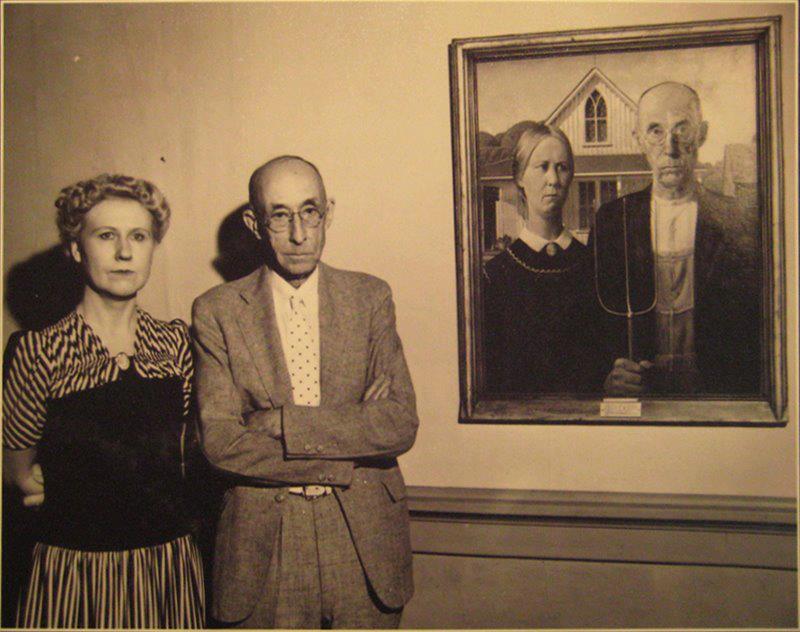Because of its fame, this painting has been interpreted in different ways and antique valuations. Some have scolded it for its caricatured depiction of the inhabitants of a cosy American state. Others have criticized it for its idealization of the denial of progress and civilization. Others said the author was criticizing and making fun of the entire American countryside. And one farmer even promised to bite off the artist's ear! One loud name of the father of American Gothic makes such antique paintings for sale fabulously expensive - and rightly so because those are priceless!
Creating his painting American Gothic (1930), at that time unknown artist from Iowa Grant Wood could not even imagine that this small thing (74 x 62 cm) painted in oil on beaverboard (wood-fibre board), destined soon to become a true "icon" of North American painting, the most famous, quoted, parodied and reproduced picture of the United States throughout the history of this young state.
Grant Wood, of course, did not dream of anything like crowds of antantique dealers that buy antiques of the best of the best would hunt the auctions for his pieces. He lived quietly in his Midwest, graduated from the University of Chicago School of Art, worked in jewellery (making silverware) and travelled four times between 1920 and 1928 to Europe to view the masterpieces of art there.
And back then, in 1930, while in Eldon, Iowa, Wood drew his attention to a tiny, neat white house, lined with wood and built in the style of "Carpenter's Gothic".The paintings of the Northern Renaissance he had seen in the Old World immediately came to life in his mind, and he decided to paint something similar - but on "domestic" American material.
Wood invited his sister Nan to pose as his female model (a common technique of artists who have not yet achieved fame, allowing him to save money on sitters), and she, going to meet her brother's wishes, even sewed on the archaic apron even more ancient trim, borrowing it from the old clothes of his mother.
.jpg)
Grant Wood. Portrait of Nan. 1933. Source: Wikipedia
As for the stern man with the piercing gaze and the same sharp pitchfork, the artist's dentist, Byron McKeebee, was perfect for the role. By the way, Byron asked to portray him not one-to-one, so that his acquaintances would not recognize him. As you may see by comparing Byron photos and the painting, Wood did the opposite

Nan Wood Graham and their dentist Dr Byron McKeeby are posing beside their painted doubles. Source: elephantart
Wood never put the characters together, and certainly never took them to the house in Eldon.
He painted the house and outbuildings separately, then the sister, then the dentist-and it turned out very well. This grotesque depiction of villagers is an imprint of the artist's childhood. These are the kind of people who surrounded him growing up on a farm, these are the kind of people the country is built on, the author believed. Wood even justified himself by saying, "I wasn't writing satire. I was trying to portray these people as they were to me in the life I knew."
There’s like a couple of puritanical, gruff Midwestern natives who pray to God with the same regularity as the sun rises in the east and sets in the west, but who, if anything goes wrong, stab you with a pitchfork as easily as they drive it into a haystack, then wash their hands, pray and eat their evening meal.
God knows, it's hard to call this couple too attractive: those pressed lips, resentful and at the same time aggressively defiant look, the absolute narrowness of outlook and unwillingness to take into account any opinion, except his own... You may be lucky if you share their views, but God forbid you should be their enemy!
The painting is devoid of any irrelevant details, strict, precise, minimalistic and reminiscent of American photographs of the late 19th century - exactly the effect Wood wanted, it seems.
The picture seemed so successful, that Grant sent it to the competition organized by the Art Institute of Chicago. The jury initially did not appreciate the artist's talents, calling American Gothic a humorous valentine - but there was one admirer of the painting among the judges (he happened to be the curator of the museum) who managed to convince the other judges that American Gothic is "much more valuable fur". And right from that day, Woods’s life has changed completely! By the way they were completely right – some of experts in selling antiques estimate that to buy vintage paintings of Woods would cost you a few million dollars!
Cover image: Grant Wood. Self-portrait. 1932. Source: Wikipedia Grant Wood. American Gothic. 1930. Source: Wikipedia

